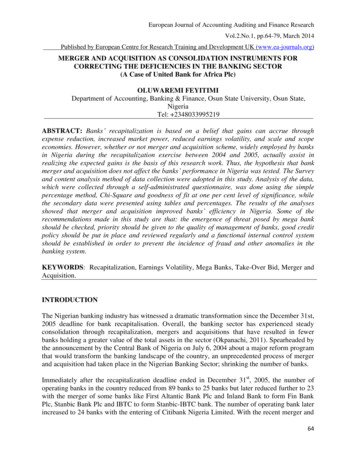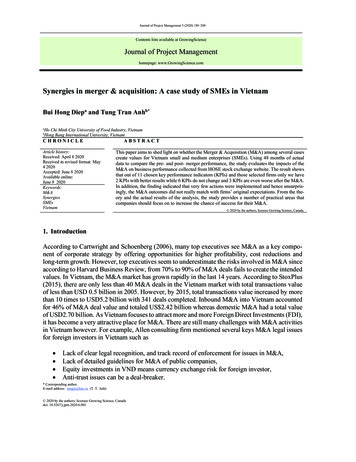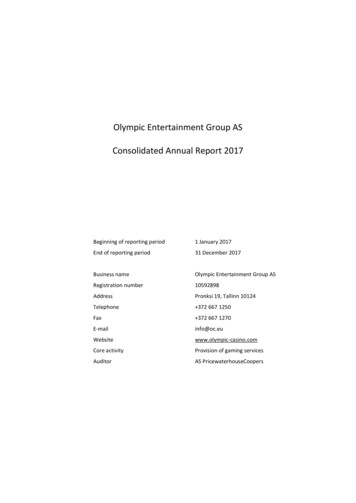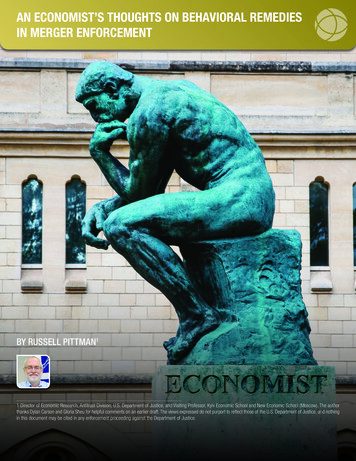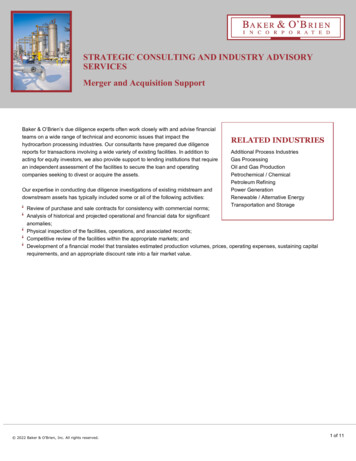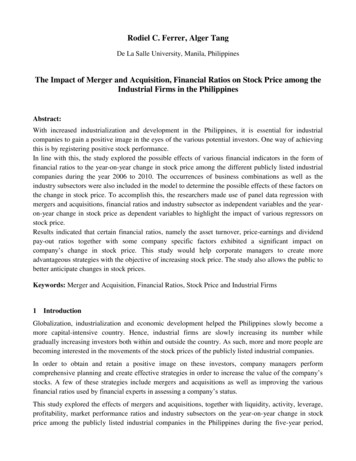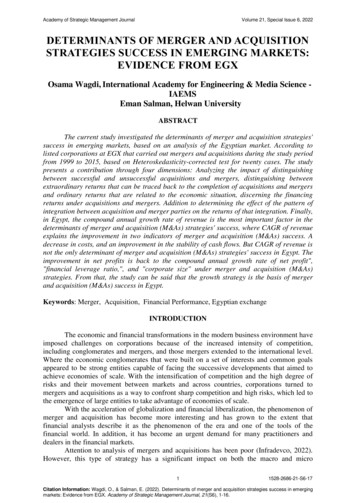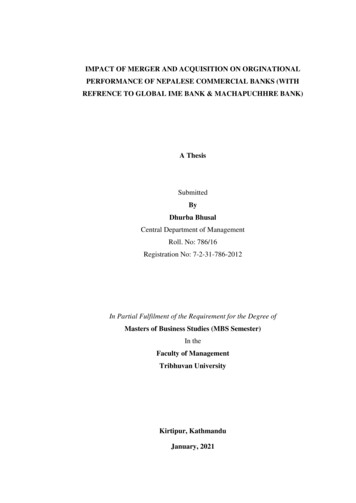
Transcription
IMPACT OF MERGER AND ACQUISITION ON ORGINATIONALPERFORMANCE OF NEPALESE COMMERCIAL BANKS (WITHREFRENCE TO GLOBAL IME BANK & MACHAPUCHHRE BANK)A ThesisSubmittedByDhurba BhusalCentral Department of ManagementRoll. No: 786/16Registration No: 7-2-31-786-2012In Partial Fulfilment of the Requirement for the Degree ofMasters of Business Studies (MBS Semester)In theFaculty of ManagementTribhuvan UniversityKirtipur, KathmanduJanuary, 2021
iiCERTIFICATION OF AUTHORSHIPI certify that the work in this thesis has not previously been submitted for a degreenor has it been submitted as part of requirements for a degree except as fullyacknowledged within the text.I also certify that the thesis has been written by me. Any help that I have receivedin my research work and the preparation of the thesis itself has beenacknowledged. In addition, I certify that all information sources and literature usedare indicated in the reference section of the thesis. .Dhurba BhusalExam Roll No.: 786/16TU Reg. No.: 7-2-31-786-2012Date: January 2021
iiiRECOMMENDATION LETTERIt is certified that thesis entitled IMPACT OF MERGER AND MMERCIAL BANKS (WITH REFERENCE TO GLOBAL IME BANK& MACHHPUCHHRE BANK) submitted by Dhurba Bhusal is an originalpiece of research work carried out by the candidate under my supervision literarypresentation is satisfactory and the thesis is in a form suitable for publication.Work evinces the capacity of the candidate for critical examination andindependent judgement. Candidate has put in at least 60 days after registering theproposal. The thesis is forwarded for examination. .Asso. Prof. Dr. Dhruba Lal PandayThesis SupervisorCentral Department of ManagementTribhuvan University, Kathmandu NepalDate: January, 2021
ivAPPROVAL-SHEETWe, the undersigned, have examined the thesis entitled IMPACT OF MERGERAND ACQUISITION ON ORGINAZATIONAL PERFORMANCE OFNEPALESE COMMERCIAL BANKS (WITH REFERENCE GLOBAL IMEBANK AND MACHHAPUCHHRE BANK) presented by Dhurba Bhusal, acandidate for the degree of Master of Business Studies (MBS) and conducted theviva voce examination of the candidate. We hereby certify that the thesis is worthyof acceptance. .Prof. Dr. Dhruba Lal PandayThesis Supervisor .Lecturer Dr. Bal Ram DuwalInternal Examiner .Lecturer Sanjaya Kumar GhimireExternal Examiner .Prof. Dr. Sanjay Kumar ShresthaChairperson, Research Committee .Prof. Dr. Ramji GautamHead of DepartmentDate: January, 2021
vACKNOWLEDGEMENTSAs the partial fulfillment of the MBS degree, I have prepared this thesis. Duringthe course, I worked with sincerely honestly and diligence, as far as possible.However, beside my continual efforts, I also got unforgettable support fromdifferent people and parties. I am extremely grateful and overwhelmed by theirsupport while completing my work.Firstly, I would like to express to genuine gratitude to my Supervisor Prof. Dr.Dhruba Lal Panday for this immense support in the entire thesis writing process,with this knowledge and excellent guidance. Supervisors pivotal supportsproviding essential materials encouraged and motivated me for completing mythesis workI am thankful to Central Department of Management for providing opportunity tocarry out this research programme, also thankful to Prof. Dr. Sanjay Shrestha Forguidance and support. I am also thankful to Global IME bank and Machapuchhrebank staff team for providing me essential support to complete this thesis work.Lastly, I would like to conclude that I am very grateful to all of my well-wisherswho have directly and indirectly contributed to accomplish this task.Dhurba BhusalCentral Department of ManagementTribhuvan University, Kathmandu, Nepal
viTable of ContentsTitle PagePage No.:iCertificate of AuthorshipiiRecommendationiiiApproval SheetivAcknowledgementsvTable of ContentsviList of TablesviiAbbreviationsviiiAbstractixCHAPTER 1: INTRODUCTION . 1-71.1Background of the study. 11.2Statement of the problems . 41.3Objectives of study . 51.4Rationale of the study . 51.5Limitation of the study. 61.6Chapter plan . 7CHAPTER 2: REVIEW OF LITERATURE . 8-182.1.Conceptual review . 82.2Review of previous works . 142.3Conceptual framework . 1472.4Research gap . 178CHAPTER 3: METHODOLOGY . 19-233.1Research design . 193.2Population and sample . 193.3Sources of data . 203.4.Data collection procedure . 213.5.Data processing procedure . 213.6Data analysis tools techniques . 21CHAPTER 4: RESULTS AND DISSCUSSION. 24-42
vii4.1Impact of M&A on financial performance of merged BFIs . 244.2Impact of merged banks employees satisfaction position . 344.3Major findings of the study. 394.3Discussion . 40CHAPTER 5: SUMMARY AND CONCLUSION . 43-455.1Summary . 435.2Conclusion . 445.3Implication . 45REFERENCES . 46-48Appendix 49-60
viiiLIST OF TABLESTable No.TitlePage No.3.1 Merged banks204.1. Financial performance of global IME Bank Ltd254.2 Financial performance Indicator of Machhapuchhre bank304.3 Employee satisfaction position35
ixABBREVIATIONSADBAsian Development BankAGMAnnual General MeetingATSAutomated Trading SystemB.S.Bikram SambatBAFIABank and Financial Institutions ActBFIsBank and Financial InstitutionsBODBoard of DirectorsCBONCentral Bank of NepalCEOChief Executive officerCITCitizen Investment TrustCo.CompanyCROCompany’s Registrar OfficeDPSDividend Per ShareEPFEmployment Provident FundEPSEarnings per ShareFIFOFirst In First OutFNCCIFederationofNepaleseCommerce and IndustriesFYFiscal YearGDPGross Domestic ProductionGNGovernment of NepalIMFInternational Monetary FundIPOInitial Public OfferingChamberof
xLOILetter of IntentLtd.LimitedM &AMerger and AcquisitionM&AMerger and AcquisitionMOFMinistry of FinanceMOUMutaual understandingNASDAQNational Association of Securities DealerAutomated Quotation SystemNBLNepal Bank LimitedNCMLNIDC Capital Market Ltd.NEPSENepal Stock ExchangeNINational IncomeNIDCNepal Industrial Development CorporationNPATNet profit After TaxNRBNepal Rasta BankNSTCNepal Security Trading CenterOTCOver- The –Counter Pref. PreferenceROEReturn on EquitySEBOSecurity BoardSEBONSecurity Board of NepalSECSecurity Exchange CenterSEDSustainable Economic DevelopmentSEQShareholder’s EquitySMCSecurities Marketing Centre
xiSWOTStrength, Weakness, Opportunities & ThreatTUTribhuvan UniversityVol.VolumeWANWide Area Network
xiiABSTRACTMergers and Acquisitions is an important financial tool that enables companies togrow faster and provide returns to owners and investors. A merger is the completeabsorption of one firm by another, wherein the acquiring firm retains the identityand the acquired firm ceases to exist as a separate entity. A merger is a corporatestrategy usually done between two or more than two companies where acquiringfirm and acquired firm stand on a merger agreement. The terms merger andconsolidation have been used synonymously. However, the two have different legalidentities after the merger deal.Researcher has been employed the descriptive and causal comparative researchdesign. Descriptive research design used to identify the level of employeesatisfaction position, merger and acquisitions, merger by laws, bank and financialindices. Descriptive research design attempts to obtain a complete and accuratedescription of a situation. The perception of the direction, magnitude and forms ofobserved relationship between merger and the bank performance as well as thefactor affection them. Moreover, this study has also employed casual comparativeresearch design to determine the effect of those variables in the bank performanceand employee's perception towards the same.This study examines the impact of Merger and Acquisition on profitability of banksand assess the satisfaction position of employee after merger. There is satisfactoryin credit to deposit ratio after merger of both banks. There is efficiently managedtheir assets to generate earnings when merger and acquisition of both banks. Thereturn of asset (ROA, ROI) both banks are enabling to increase in comparison topremerger. There is fluctuation trend of net profit margin of Global IME bank butas a average there was increasing value in post-merger period and there is rapidlyincrease of net profit margin of Machhapuchchhre bank after merger. As mergedentity reported a better financial performance in post-merger period then premerger period.In the banks there are very few employees having qualification of intermediatelevel, majority of the employee they are happier with their work- they happier
xiiibecause they have specified work place, defined work time, no pressure ofmanipulation, good understanding co-worker than pre- merger period. They feelcompetitive employee in the market and recognized as a professional on their workplace. But some of the employee has inconvenience about the specified training forexample: loan department employee.
1CHAPTER 1INTRODUCTION1.1 Background of the studyMergers and Acquisitions is an important financial tool that enables companies togrow faster and provide returns to owners and investors (Sherman Hart, 2006).According to Ross.et.al. (2003), “A merger is the complete absorption of one firm byanother, wherein the acquiring firm retains the identity and the acquired firm ceases toexist as a separate entity”. A merger is a corporate strategy usually done between twoor more than two companies where acquiring firm and acquired firm stand on amerger agreement. The terms merger and consolidation have been usedsynonymously. However, the two have different legal identities after the merger deal.In a consolidation, two firms come together to create an entirely new firm. Both theacquiring firm and the acquired firm dissolve their previous names and identity (Rosset.al, 2003). In practice, a merger between company A company B company A,where company B merged with company A. In a consolidation, company A company B company C, where company C is an entirely new company (Gaughan,2002).“An acquisition is a transaction in which an individual or company, known as theofferor (or acquirer) gains control of the management and assets of another company,known as the offeree (or target), either by becoming the owner of these assets orindirectly by obtaining control of the management of the company, or by acquiringthe shares” (Firer.et.al. 2004). Acquisition can be done either by purchasing the stockand/or assets of the target company. A takeover is another form of acquisition whichcan be used interchangeably. Typically, a takeover is unfriendly and hostile in natureand without the will of target firms. Acquisitions are friendlier where bothcorporations mutually agree to become a part of one to another. (Ross et.al, 2003;Firer-Ross-Westerfield-Jordan, 2004)According to Shrestha (2012), the concept of M&A was an entirely new thing to theBanking and Financial Institutions (BFIs) of Nepal when the Nepal Rastra Bank,
2supervisory and regulatory body of all the BFIs has issued merger by-laws in May2011. “It is something in which Nepal Rastra Bank has been preparing for years”(Gyanwali 2011). However, many had doubts that the BFIs would go for mergerimmediately as there were no separate acts and decree for a merger implementation.The objective of the merger by-laws is to strengthen the BFIs position andperformance by reducing the number of institutions. The merger bylaws have aprovision that can pressurize all BFIs to go for an immediate merger in the form ofconsolidation (Nepal Share Bazar, 2013).The Nepalese financial sector has witnessed a tremendous growth in the number offinancial institutions after the 1980’s by adopting an economic liberalizationregulation with a mixed economic model. However, the unnatural increment of theBFIs has brought several financial challenges and complexities. The financialindicator had indicated that the Nepalese financial sector was weak, vulnerable and, atthe verge of a collapse. “Merger is a golden opportunity for BFIs. This facility isfloated to reduce the number of BFIs to strengthen them” (The Himalayan Times,2013). According to the monetary policy report of the Nepal Rastra Bank (2016), thetotal number of the BFIs stood at 179 including 28A class commercial banks, 67 Bclass development banks, 42C class finance companies, and 42 D class micro financeinstitutions.In the beginning, the merger bylaws had failed to create immediate impression in thebanking fraternity and the merger bylaws in the form of consolidation have gainedacceleration over the last two years in 2011 and 2013 when the HimchuliDevelopment Bank and Birgunj Finance first sparked the merger trend andconsolidated to become the H&B Development Bank. The merger bylaws policyintroduced by the Nepal Central Bank in the year 2011 has been successful as almostone fourth of the financial institutions have opted mergers (Singh, 2013)There is some confusion about the terminology of merger, consolidation, acquisition,and takeover. This is why the term used tends to be similar and can be usedinterchangeably (Sherman-Hart, 2006). As cited in the definition of merger, theunderlying principle of merger and acquisition is to maximize the shareholders profit
3by maximizing the profit of business corporations. However, each term carries aslightly different meaning under business situations. A merger is a combination ofrelatively same size companies forming a new company. Usually, a merger takesplace on friendly terms and the newly created company shares equal profit among thestakeholders. The primary purpose of a merger is to expand their business operations.However, when one company takes over another company in the form of equity orand assets, it is known as acquisitions. An acquisition is mainly taken during theeconomic recession and constant decline of company profits. (Ross et.al 2003; Fireret.al, 2004)Another significant difference between a merger and an acquisition lies in dealing ofacquiring between firms. In an acquisition, a deal can be done without the mutualconsent of the target company. Usually, the bigger, stronger and larger companiesshallow the operation of a weak company. In case of a merger, the deal betweenmerging companies is friendly where both the parties share the same percentage ofownership and profit. (Ross et.al 2003; Firer et.al, 2004)There are three major types of merger and acquisition which are driven by differentcorporate strategies. They are categorized into horizontal, vertical and conglomerate.Each of the types possesses characteristics at the outset. (Ross et.al 2003)Merger and Acquisition has become a corporate strategy enabling a firm to strengthenits core competencies. The factors affecting mergers change with their changing legal,political, economic and social environments. Firms engage in a merger andacquisitions activity for different economic reasons. The most common motives offirms for mergers and acquisitions are synergy, revenue enhancement, cost reduction,tax gains.Merger and acquisition have become a corporate strategy to increase the corecompetences of organization. It affects the overall performance, each and every aspectof organization so it is necessary to research in this field. A lot of speculations havebeen going on in the financial sector whether the merger policy will be fruitful tostrengthen the Nepalese bank and financial institutions. Some positive signals havebeen visible in the financial institutions as 43 financial institutions including
4commercial banks, development banks and finance companies have merged so far anda few BFIs are in pipelines and some have got the letter of intent. This depicts thatmerger and consolidation has gradually taken place in the banking industry. The goalof this research is to find out the effect and impact of the merger policy adopted bythe Nepal Rastra Bank. The research is carried out by analyzing the financialstatements of the BFIs involved in the merger activity. A comparison is made betweenpre-merger performance and post-merger performance of the BFIs. In addition to it, asurvey research is conducted by using a list of questionnaires to explore the impact ofthe merger policy on the employees and customers.1.2 Statement of the problemsMerger is assumed as a tool for strengthens banks capacity and level of performance,but all merged institution is not delivering the expected performance. Variousresearchers concluded that post-merger banks have found their decreased ROE, ROA,decreased profit, negative feeling towards merged organization and strong evidence ofuncertainty over the very existence of economics of scale.Recently, the financial institutions of Nepal have been characterized by a low volumeof turnover, high interest rate in lending, high interest rate spread, inefficientmanagement, and lack of project financing practice, inadequate working fund andunhealthy competition. Some financial institutions such as the Gorkha DevelopmentBank, Nepal Share Market, Capital Merchant and Finance were caught with a weaksupervision and miss corporate governance. Moreover, the state-owned financialinstitutions such as the Rastriya Banijya Bank and the Agriculture Development Bankare marked with excessive operating expenses and low operating profits. Thus,merger by law has been issued by Nepal Rastra Bank. M&A effect on each.Though the merger trend is increasing in Nepal, it has witnessed challenge making thesuccess of merged institution in doubt unexpected leaving of top-level management.Huge cost incurred in data migration and settlement of duplicate branches. Theeffective of post management of post-merger scenario plays vital to maintainemployee psychological status to satisfy, retain and attract their decreased
5motivational level, strong risk of job security. So, this study has tried to address thefollowing research issues:i.What is the impact of Merger and Acquisition on profitability of Bank andFinancial Institutions?ii.What is the impact of Merger and Acquisition on employee satisfactionposition?1.3 Objectives of studyThis research work provides a comprehensive insight to the ongoing Merger andAcquisitions transaction in the Nepalese Banking and Financial Institutions (BFIs)since 2011 when the Nepal Rastra Bank, as a supervisory and regulatory body of allthe BFIs, introduced a forceful merger by-law in May 2011. The main objective ofthis research work is to explore the possible effects and impacts on the financialPerformance of BFIs caused by M&A since 2011 in the Nepalese financial sector.Fowling specific objective can be mention to make the study easier:i.To examine the impact of Merger and Acquisition on profitability of banks.ii.To assess the satisfaction position of employee after merger.1.4 Rationale of the studyWith the change in the organization environment the environment the adaptation tothe changes becomes crucial problem. When two or more banks get merge, then theenvironmental structure change. With the change in such structure employee mightnot be satisfied which hinders the performance of the organization.I found various gap on previous research in this topic M & A on banking industry Iwill not able to equip all information of deviated on merging and acquisition but mybest tries to find out what exactly performance performed by post and pre-mergereffect on these particular banking performances.To all practitioners within the banking industry, the outcome of this research couldfacilitate better understanding factor affecting the bank performance which can beused to increase competitive advantage in value and performance among others afterM& A. the major research findings of this study provide the opportunity to manage
6employee effectively for higher productivity. That helps to identify the shortcomingand strength of their human resources management practice of particular banks andhow employee satisfaction affects the performance of banks as well as its profitabilitybeneficiary i.e. shareholders and other stake holder can use those providedinformation to evaluate for their financing purpose. (Debt provider, depositor,governing institution etc.). It is greater significance towards academic as the newframework and findings are useful for future research tool to assess level of employeesatisfaction.1.5 Limitation of the studyIn Every research there need to be fix some area of study. In this study there are alsosome limitations while doing it & which are as follows: i. This study the merged banks only two merged banks namedMachhapuchhre bank and Global IME bank are taken as sample randomly.ii.This study could not cover all the aspect of bank and financial Institution.It only covers performance level of bank in the form of earning per share,profitability, return on equity, return on asset and perception of employeetowards the merger and performance. It does not consider the problems ofmerger stock market reaction after announcement of merger, adequacy oflegal provision, institutional arrangement.iii.Study has used convenient as well as casual comparative survey method tocollect primary data from the merger institutions. The study doesn’t havespecific sampling technique for the selection of the enterprise for thesurvey.iv.This study doesn’t include the responses from the top-level manager in theorganization. Only middle level and some lower level employees'responses were taken for the analysis.v.Resources and time factors also limit of the study and only 5 years periodof data after merger presented in a sample.vi.The sample is small and before merger bank data has been shown forcalculation pre-merger ratio analysis.
71.6 Chapter planIn this research the whole study would be developed into five major chapters anddivided into sub categories as per requirement.Chapter 1: Introduction:This chapter has included Background of the study, Objectives of the study, Researchhypothesis, Statement of the problem, and Significance of the study and Limitation ofthe study.Chapter 2: Review of literatures:This chapter has included Review of act, rules, research report, thesis and dissertationetc. which are related to this topic.Chapter 3: Research methodology:This chapter has included Research Methodology under which the research design,population & sample, sampling procedure, Data Collection procedure, StatisticalProcedure and Data Analysis.Chapter 4: Presentation and analysis of data:This chapter includes the Data Presentation and analysis and then the major findingsof the study has present here with the help of various statistical tools followed bymethodology.Chapter 5: Summary, conclusion & recommendation:This chapter includes Summary & conclusions of major finding withrecommendation.Bibliography and appendix have also been incorporated at the end of the study.
8CHAPTER 2REVIEW OF LITERATUREThis chapter deals with Conceptual Review and Research Review. Conceptual reviewcovers the basic terms used in the studies and research reviews includes the review ofMasters Dissertation, International journals and Nepalese journals.2.1. Conceptual reviewTheoretical review refers to the basic concept of the related subject such as Merger,Acquisition, different between merger and acquisition, Merger by laws etc. It clarifiesand make easy to understand the real meaning and things about merger andacquisition.2.1.1 Difference between mergers and acquisitionsThere is some confusion about the terminology of merger, consolidation, acquisition,and takeover. This is why the term used tends to be similar and can be usedinterchangeably. (Sherman-Hart, 2006)As cited in the definition of merger, the underlying principle of merger andacquisition is to maximize the shareholders profit by maximizing the profit ofbusiness corporations. However, each term carries a slightly different meaning underbusiness situations. A merger is a combination of relatively same size companiesforming a new company. Usually, a merger takes place on friendly terms and thenewly created company shares equal profit among the stakeholders. The primarypurpose of a merger is to expand their business operations. However, when onecompany takes over another company in the form of equity or/and assets, it is knownas acquisitions. An acquisition is mainly taken during the economic recession andconstant decline of company profits. (Ross.et.al, 2003)Another significant difference between a merger and an acquisition lies in dealing ofacquiring between firms. In an acquisition, a deal can be done without the mutualconsent of the target company. Usually, the bigger, stronger and larger companiesshallow the operation of a weak company. In case of a merger, the deal between
9merging companies is friendly where both the parties share the same percentage ofownership and profit (Firer.et.al, 2004)2.1.2. Types of merger and acquisitionThere are three major types of merger and acquisition which are driven by differentcorporate strategies. They are categorized into horizontal, vertical and conglomerate.Each of the types possesses characteristics at the outset. (Ross.et.al, 2003)a) Horizontal mergersHorizontal Mergers takes place when two or more competitors operating in the sameline of business combine together. Gaughan, (2002) states that if a horizontal mergercauses the combined firm to experience an increase in the market power that will havean anticompetitive effect the merger may be opposed on antitrust ground. In additionto market power, the horizontal merger produces ripple effects when two small scalecompanies’ joint together to gain competitive advantage over the competitor.(Ross.et.al, 2003)Horizontal mergers have been the most important and prevalent form of mergers inNepal. The Nepalese financial sector has witnessed twenty sets of horizontal mergersamong the Banking and Financial Institutions. The merger among banks would be ahorizontal merger. (Annual Bank Supervision Report, 2012)b) Vertical mergersA vertical merger refers to the expansion of firms caused either by mergers betweentwo firms involved at successive stages of the production process or by firmsdeveloping their own vertical operations. (Lipczynski-Wilson, 2004)Firms choose a vertical merger to gain efficiency in the business supply chain and toimprove profitability position by the effect of economies of scale.c) Conglomerate mergersA conglomerate merger occurs when the companies are not competitors and do nothave buyer-seller relations. One example would be a Philip Morris, a tobaccocompany, which acquired General Foods in 1985 for 5.6 billion. (Gaughan, 2002)
102.1.3. Motives for merger and acquisitionMerger and Acquisition has become a corporate strategy enabling a firm to strengthenits core competencies. The factors affecting mergers change with their changing legal,political, economic and social environment. Firms engage in a merger andacquisitions activity for different economic reasons. The most common motives offirms for mergers and acquisitions are discussed below:a) SynergySynergy is commonly used in a merger and acquisitions activity. Synergy has beendescribed as the combined firms have a value that is greater than the sum of the valuesof the separate firms. (DePamphilips, 2011)Hypothetically the underlying principle of synergy is 2 2 5, or 5 5 11 which istechnically incorrect. However, it is believed that the net positive gain will beachieved resulting from the merger of two separate entities. Synergy can be producedas operational, managerial and financial synergies. (Ross.et.al, 2003)Operational synergy can be explained as the combination of economies of scale,which would reduce average costs as a result of mor
satisfaction position, merger and acquisitions, merger by laws, bank and financial indices. Descriptive research design attempts to obtain a complete and accurate description of a situation. The perception of the direction, magnitude and forms of observed relationship between merger and the bank performance as well as the factor affection them.
